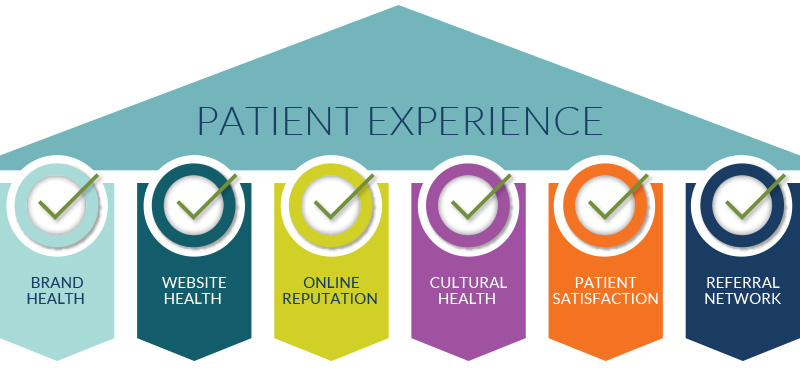Patient experience has become a buzzword, and in that regard, the concept is all too easy to ignore. But the trendiness of the term belies just how essential the concept of patient experience has become to the success of healthcare providers across the country. One survey found that 90% of hospitals and providers believe that patient experience is the single most effective means of differentiating themselves from their competition.
Retailers such as Apple and Amazon have perfected the customer experience, but it would be a mistake for healthcare providers, hospitals, and ambulatory surgical centers to follow that blueprint. Patients don’t want to feel like commodities.
That’s why PatientX has developed its own healthcare Pillars of Marketing, which can effectively enhance the patient experience in a way that’s unique to healthcare. This brief look at the pillars just scratches the surface. Each principle–and every healthcare provider–will require a deliberate and unique approach to achieve improvements in patient experience. But it helps to know where to start.
Six Ways to Improve the Patient Experience with Healthcare Marketing
Most patients are not consciously attempting to define their experience in real time. That can leave providers with a paralyzing lack of direction. Maybe you’re thinking: marketing my Ambulatory Surgery Center (ASC) or clinic is about bringing new patients in–not about making them happier. After all, patient experience can be a rather broad and nebulous concept.
Focusing on these six pillars can help your hospital, ASC, or practice do both!

Pillar #1: Brand Health
A brand is more than a mascot–it’s a way of communicating your mission, your values, and your credibility. The font you choose, the colors you adopt, and the logo you design become a cohesive representation of who you are. When all of these elements work together to create a narrative, it’s easier for patients to plug their own experience into that story. That’s why it’s essential that your branding be effective and universal.
Evaluating your brand health usually starts with a full audit of your physical and digital assets (including social media) to ensure that your brand message is faithfully and effectively communicated across all platforms. Business cards, exterior signage, and even wall colors should all be used to leverage your message and your identity. Use every opportunity to tell your patients who you are.
Pillar #2: Website Health
Whether you’re a hospital, an ACS, or a neighborhood clinic, your website has always been an important healthcare marketing tool. But as COVID-19 has made in-office visits less practical, a patient’s online experience is often that patient’s only experience. A website that functions flawlessly, looks fantastic, and is easy to navigate can communicate to patients that your office is modern, professional, and highly skilled. Patients are then more likely to feel good about any ensuing interactions and experiences.
Specific steps to improve your website health could include: ensuring your website loads quickly, integrating telemedicine and telehealth into your website, ensuring you have a modern and effective design, or taking steps to meet accessibility standards. A patient that has an easy time navigating your website is much more likely to have a favorable patient experience.
Pillar #3: Online Reputation
Modern patients treat medical procedures in much the same way as they do dining out: they want to check reviews first. Patients can leave reviews in Google or at specialty websites such as HealthGrades, Vitals, or ZocDoc. As patient experience becomes more important, patients want some assurances that they will have a good experience.
As a result, managing your online reputation has become an essential part of healthcare marketing. Encouraging patients to leave reviews and following up with negative comments can help patients know what to expect from your practice. High expectations will often translate into a stellar patient experience when those expectations are met–which in turn could lead to more favorable reviews.
Pillar #4: Cultural Health
Patients know when they’re surrounded by unhappy staff. It’s not a feeling that inspires confidence, so it’s no surprise that strong cultural health can improve the overall patient experience.
Cultural health isn’t only measured in staff happiness, of course. A healthy culture might consist of mutual respect, adherence to rules and protocols, and accountability at all levels. Every practice, hospital, and ASC will have its own unique culture, but generally speaking, happy employees will deliver better service. And that will almost certainly result in a superior patient experience.
Pillar #5: Patient Satisfaction
Patient satisfaction would seem to be something that is central to all good healthcare. The trouble is that it’s easy to see satisfied patients everywhere–providers work hard to deliver quality care, so there’s a natural bias to assume that everyone who goes home does so with a smile. That’s why collecting data on patient satisfaction, through surveys or questionnaires, is so vital.
True, the results can surprise you. But surprising results are good because they often reveal areas of opportunity. Collecting patient satisfaction data can provide you with actionable ways to improve, augment, or reinforce good experiences for your patients.
Pillar #6: Referral Network
Referrals are a routine and often unremarkable feature of modern medicine. But patients don’t always see it that way. Indeed, patients often read a referral as an endorsement of another healthcare professional. In that way, your referral network can often reflect strongly on your practice, hospital, or ASC. Maybe you’re already thinking, “Marketing my ASC is already all about referrals. But those referrals can impact patient experience as well.
If you refer a patient to a specialist who is capable, kind, and goes above and beyond, that patient will typically look at the entire experience in a more favorable light–and you will benefit as a result. Ensuring that every aspect of your referral network reflects well on you–and vice versa–can help ensure a more cohesive and positive patient experience across the board.
Patient Experience Will Only Become More Important
In many ways, COVID-19 has broadened the boundaries of patient experience beyond the walls of any hospital, ASC, or clinic. Now patients will reflect on how easy it was to use your website or set up a telemedicine chat. But that also means that healthcare providers and marketers have more opportunities to improve the experiences they offer.
The pandemic may have accelerated this emphasis on patient experience, but the trend has been growing for years–and all the data indicates it’s here to stay. For healthcare providers and marketers, focusing on these six pillars can improve how patients view your clinic or ASC–and how they rate their overall experience.
Contact PatientX to find out more about how your clinic or ASC can successfully improve patient experience via strong healthcare marketing.


